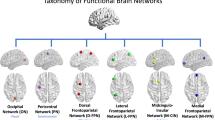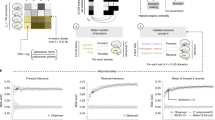Abstract
The growing literature reporting results of cognitive-neural mappings has increased calls for an adequate organizing ontology, or taxonomy, of these mappings. This enterprise is non-trivial, as relevant dimensions that might contribute to such an ontology are not yet agreed upon. We propose that any candidate dimensions should be evaluated on their ability to explain observed differences in functional neuroimaging activation patterns. In this study, we use a large sample of task-based functional magnetic resonance imaging (task-fMRI) results and a data-driven strategy to identify these dimensions. First, using a data-driven dimension reduction approach and multivariate distance matrix regression (MDMR), we quantify the variance among activation maps that is explained by existing ontological dimensions. We find that ‘task paradigm’ categories explain more variance among task-activation maps than other dimensions, including latent cognitive categories. Surprisingly, ‘study ID’, or the study from which each activation map was reported, explained close to 50% of the variance in activation patterns. Using a clustering approach that allows for overlapping clusters, we derived data-driven latent activation states, associated with re-occurring configurations of the canonical frontoparietal, salience, sensory-motor, and default mode network activation patterns. Importantly, with only four data-driven latent dimensions, one can explain greater variance among activation maps than all conventional ontological dimensions combined. These latent dimensions may inform a data-driven cognitive ontology, and suggest that current descriptions of cognitive processes and the tasks used to elicit them do not accurately reflect activation patterns commonly observed in the human brain.






Similar content being viewed by others
References
Bolt, T., Nomi, J. S., Yeo, B. T. T., & Uddin, L. Q. (2017). Data-driven extraction of a nested model of human brain function. J Neurosci, 37, 7263–7277.
Boutsidis, C., & Gallopoulos, E. (2008). SVD based initialization: A head start for nonnegative matrix factorization. Pattern Recogn, 41, 1350–1362.
Dhillon, I. S., & Modha, D. S. (2001). Concept decompositions for large sparse text data using clustering. Mach Learn, 42, 143–175.
Eklund, A., Nichols, T. E., & Knutsson, H. (2016). Cluster failure: Why fMRI inferences for spatial extent have inflated false-positive rates. Proc Natl Acad Sci, 113, 7900–7905.
Fox, P. T., & Lancaster, J. L. (2002). Mapping context and content: The BrainMap model. Nat Rev Neurosci, 3, 319–321.
Fox, M. D., Snyder, A. Z., Vincent, J. L., Corbetta, M., van Essen, D., & Raichle, M. E. (2005). The human brain is intrinsically organized into dynamic, anticorrelated functional networks. Proc Natl Acad Sci U S A, 102, 9673–9678.
Friedman, L., Kenny, J. T., Wise, A. L., Wu, D., Stuve, T. A., Miller, D. A., Jesberger, J. A., & Lewin, J. S. (1998). Brain activation during silent word generation evaluated with functional MRI. Brain Lang, 64, 231–256.
Garcia, D. (2010). Robust smoothing of gridded data in one and higher dimensions with missing values. Comput Stat Data Anal, 54, 1167–1178.
Gorgolewski, K. J. et al. (2015) NeuroVault.org: a web-based repository for collecting and sharing unthresholded statistical maps of the human brain. Front. Neuroinformatics9, 8.
Hastings, J. et al. (2014) Interdisciplinary perspectives on the development, integration, and application of cognitive ontologies. Front. Neuroinformatics 8
Haxby, J. V., Gobbini, M. I., Furey, M. L., Ishai, A., Schouten, J. L., & Pietrini, P. (2001). Distributed and overlapping representations of faces and objects in ventral temporal cortex. Science, 293, 2425–2430.
Kim, J., & Park, H. (2011). Fast nonnegative matrix factorization: An active-set-like method and comparisons. SIAM J Sci Comput, 33, 3261–3281.
Kuang, D., Ding, C. & Park, H. Symmetric Nonnegative Matrix Factorization for Graph Clustering. in Proceedings of the 2012 SIAM International Conference on Data Mining 106–117 (Society for Industrial and Applied Mathematics, 2012). doi:https://doi.org/10.1137/1.9781611972825.10
Laird, A. R., et al. (2015). Neural architecture underlying classification of face perception paradigms. NeuroImage, 119, 70–80.
Lancaster, J. L., Tordesillas-Gutiérrez, D., Martinez, M., Salinas, F., Evans, A., Zilles, K., Mazziotta, J. C., & Fox, P. T. (2007). Bias between MNI and Talairach coordinates analyzed using the ICBM-152 brain template. Hum Brain Mapp, 28, 1194–1205.
Lee, D. D., & Seung, H. S. (1999). Learning the parts of objects by non-negative matrix factorization. Nature, 401, 788–791.
Lohmann, G., Volz, K. G., & Ullsperger, M. (2007). Using non-negative matrix factorization for single-trial analysis of fMRI data. NeuroImage, 37, 1148–1160.
Poldrack, R. A., et al. (2011). The cognitive atlas: Toward a knowledge foundation for cognitive neuroscience. Front Neuroinformatics, 5, 17.
Poldrack, R. A. et al. (2012) Discovering relations between mind, brain, and mental disorders using topic mapping. PLoS Comput Biol 8
Raichle, M. E., et al. (2001). A default mode of brain function. Proc Natl Acad Sci, 98, 676–682.
Ray, K. L. et al. (2013) ICA model order selection of task co-activation networks. Front Neurosci 7
Rubin, T. N., et al. (2017). Decoding brain activity using a large-scale probabilistic functional-anatomical atlas of human cognition. PLoS Comput Biol, 13, e1005649.
Schmitz, R. J., Schultz, M. D., Lewsey, M. G., O'Malley, R. C., Urich, M. A., Libiger, O., Schork, N. J., & Ecker, J. R. (2011). Transgenerational epigenetic instability is a source of novel methylation variants. Science, 334, 369–373.
Shehzad, Z., et al. (2014). An multivariate distance-based analytic framework for Connectome-wide association studies. NeuroImage, 93, 74–94.
Shirkhorshidi, A. S., Aghabozorgi, S., & Wah, T. Y. (2015). A comparison study on similarity and dissimilarity measures in clustering continuous data. PLoS One, 10, e0144059.
Smith, S. M., Fox, P. T., Miller, K. L., Glahn, D. C., Fox, P. M., Mackay, C. E., Filippini, N., Watkins, K. E., Toro, R., Laird, A. R., & Beckmann, C. F. (2009). Correspondence of the brain’s functional architecture during activation and rest. Proc Natl Acad Sci U S A, 106, 13040–13045.
Sotiras, A., Resnick, S. M., & Davatzikos, C. (2015). Finding imaging patterns of structural covariance via non-negative matrix factorization. NeuroImage, 108, 1–16.
Stroop, J. (1935). Studies of interference in serial verbal reactions. J Exp Psychol, 18, 643–662.
Toro, R., Fox, P. T., & Paus, T. (2008). Functional Coactivation map of the human brain. Cereb Cortex N Y NY, 18, 2553–2559.
Turner, J. A., & Laird, A. R. (2012). The cognitive paradigm ontology: Design and application. Neuroinformatics, 10, 57–66.
Uddin, L. Q. (2015). Salience processing and insular cortical function and dysfunction. Nat Rev Neurosci, 16, 55–61.
Uddin, L. Q., Yeo, B. T. T., Spreng, R. N. (2019) Towards a Universal Taxonomy of Macro-scale Functional Human Brain Networks. Brain Topography 32 (6):926-942
Wu, S., et al. (2016). Stability-driven nonnegative matrix factorization to interpret spatial gene expression and build local gene networks. Proc Natl Acad Sci, 113, 4290–4295.
Yeo, B. T. T., et al. (2015). Functional specialization and flexibility in human association cortex. Cereb Cortex N Y N, 1991(25), 3654–3672.
Zapala, M. A., & Schork, N. J. (2006). Multivariate regression analysis of distance matrices for testing associations between gene expression patterns and related variables. Proc Natl Acad Sci, 103, 19430–19435.
Acknowledgements
The authors gratefully acknowledge Peter Fox for providing access to the BrainMap database. This work was supported by award R01MH107549 from the National Institute of Mental Health to LQU and award 1631325 from the National Science Foundation to ARL.
Author information
Authors and Affiliations
Corresponding authors
Additional information
Publisher’s Note
Springer Nature remains neutral with regard to jurisdictional claims in published maps and institutional affiliations.
Rights and permissions
About this article
Cite this article
Bolt, T., Nomi, J.S., Arens, R. et al. Ontological Dimensions of Cognitive-Neural Mappings. Neuroinform 18, 451–463 (2020). https://doi.org/10.1007/s12021-020-09454-y
Published:
Issue Date:
DOI: https://doi.org/10.1007/s12021-020-09454-y




